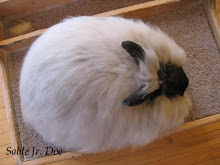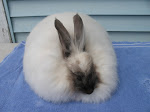Someone asked me a question about rabbit moms and litters recently, so I thought I'd make a list of baby facts:-). As someone who routinely runs her litters back and forth each day for feedings I will have different experiences than someone who leaves them with the does 24/7, but there are several neat things I've noticed over the years (probably as a result of this practice) that I thought I would post here.
1) When a litter is late it is usually because it is small
2) When a litter is a day early or right on time, it usually means there will be 7 or more babies present:)
3) The size of a litter is usually directly proportional to the amount of milk a doe is able to produce
4) Litters tend to decline in size once the doe reaches 3 years old or more
5) Does who turn around before leaving the nestbox (after nursing) will usually detach hanging kits in the process, making them less likely to drag their babies out
6) Does who go into and out of a nestbox in a leisurely fashion are also less likely to be 'kit draggers'
7) Does who jump in and out of nestboxes fast without turning much at all are does who are at the highest risk of exposing kits
8) Does tend to nurse litters longer in the first 1-2 days because the milk has not yet come in and it takes longer to fill a litter up on colostrum
9) You can always identify a litter that has been fed because their stomachs are wide and full, and they are digging frantically into the nest material
10) You can also identify a litter that has been fed if you stick your hand into the nest and the babies do not 'pop' frantically at the disturbance
11) It is completely unnecessary to cover kits or arrange nest material over them after feeding. The litter does this automatically on it's own according to how warm/cold it is outside.
12) In the summertime, kits will leave a nest open on top and lay higher up (and closer to the surface) for better ventilation
13) In the winter kits burrow much more deeply, covering themselves completely with wool and hay and retreating to the bottom of the nest.
14) The eyes of a litter open at 12 days, at exactly the same time as the ears come up
15) A kit who is failing to thrive (unable to compete, unable to consume milk) will be impossible to save in almost every instance despite every measure taken, and will expire anywhere from the third day forward.
16) A kit is generally large enough at 3 weeks of age to walk safely on floor wire without slipping through and injuring itself.
17) Footboards MUST be removed when kits are released into a cage because the openings on most boards are beveled and will create a slippery leghold trap for kits in which their legs slip through the holes but cannot be pulled out again.
18) A doe's milk production (and a litter's appetite) peaks at 3 weeks. After this the litter begins to consume solid food and the doe scales back production accordingly.
19) While good mothers are generally defined as good milk producers before the age of 3 weeks, the litter begins to watch and imitate her behaviors after this point (once the nestbox is removed). When she eats, they will eat. When she drinks, they will drink, and when she grooms, they groom. These behaviors would certainly occur anyway if the doe were not present, but they do seem to be facilitated more quickly in the presence of the doe as soon as the litter is mobile and out of the box.
20) Kits can make their own heat by the 10th day (and will not die of exposure after this point). Danger of being dragged out also ceases to exist at this point because they become too heavy for the doe to pull and they can no longer support their body weight with just their teeth:).
Anyway, these are just a few little baby observations that I've made (and continue to make in all the litters I raise). I am sure there are more and I am certain that others have noticed things in their herds as well. I will continue to post trivia as I think of it in several different areas:-)
Have a great week!
Monday, May 21, 2012
Subscribe to:
Post Comments (Atom)























1 comment:
I just came across your site today. Despite there being lots of info on the net about wooling rabbits it's difficult to find good info in one place that is organized and has pictures. Your site has both. Also, your rabbits are gorgeous! I have three english angoras. But your frenchies make me interested in them for the future. Also, I like your rabbit shed. Did you use an existing shed or find plans somewhere? What do you use for the flooring? Info about that might make a good post!
Post a Comment